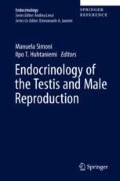Abstract
Cryopreservation is a technique that keeps the cells and tissues in a vital state, using cryogenic temperatures (−196 °C). Despite the first experiments of sperm preservation with snow dating back to the eighteenth century, it was only the discovery of the protective role of glycerol against freezing damage in the twentieth century and the use of liquid nitrogen that started the era of modern cryobiology. The use of cryoprotectants and adequate cryopreservation methods (rapid or slow freezing procedures) allow to prevent freezing damage and maintain the cells in a state of “suspended animation” which will preserve for a long time. Sperm Bank is a medical facility characterized by two purposes: to preserve the patient’s fertility and to access to assisted reproduction techniques (ART). There are many indications (neoplasms, autoimmune diseases, urological pathologies) but, as a general rule, semen or testicular tissue cryopreservation must always be executed before any therapy, which may interfere with either spermatogenesis and genome integrity or ejaculation mechanisms. Also, it is possible to cryopreserve a patient’s semen to facilitate access to ART. The activities of a Sperm Bank are strictly regulated by the current EU legislation. This involves quality standards, structural and personnel requirements, archive, traceability, storage, and distribution of human tissues and cells. These rules consist in the adoption by the various Member States of Directive 2004/23/EC and following (2006/17/EC and 2006/86/EC) issued by the European Parliament.
Loredana Gandini: deceased.
References
Behrman SJ, Sawada Y. Heterologous and homologous insemination with human semenfrozen and stored in a liquid-nitrogen refrigerator. Fertil Steril. 1966;17:457–66.
Bielanski A. A review of the risk of contamination of semen and embryos during cryopreservation and measures to limit cross-contamination during banking to prevent disease transmission in ET practices. Theriogenology. 2012;77(3):467–82.
Bresson JL, Clavequin MC, Mazeron MC, Mengelle C, Scieux C, Segondy M, Houhou N, Fédération Française des CECOS. Risk of cytomegalovirus transmission by cryopreserved semen: a study of 635 semen samples from 231 donors. Hum Reprod. 2003;18(9):1881–6.
Bunge RG, Sherman JK. Fertilizing capacity of frozen human spermatozoa. Nature. 1953;172(4382):767–8.
Chen SU, Shieh JY, Wang YH, Lu T, Ho HN, Yang YS. Successful pregnancy achieved by intracytoplasmic sperm injection using cryopreserved electroejaculate sperm in a couple both with spinal cord injury: a case report. Arch Phys Med Rehabil. 2005;86(9):1884–6.
Clarke GN, Liu DY, Baker HW. Recovery of human sperm motility and ability to interact with the human zona pellucida after more than 28 years of storage in liquid nitrogen. Fertil Steril. 2006;86(3):721–2.
Dohle GR. Male infertility in cancer patients: review of the literature. Int J Urol. 2010;17(4):327–31.
Feldschuh J, Brassel J, Durso N, Levine A. Successful sperm storage for 28 years. Fertil Steril. 2005 Oct;84(4):1017.
Gandini L, Lombardo F, Salacone P, Paoli D, Anselmo AP, Culasso F, Dondero F, Lenzi A. Testicular cancer and Hodgkin’s disease: evaluation of semen quality. Hum Reprod. 2003;18(4):796.
Gandini L, Sgrò P, Lombardo F, Paoli D, Culasso F, Toselli L, Tsamatropoulos P, Lenzi A. Effect of chemo- or radiotherapy on sperm parameters of testicular cancer patients. Hum Reprod. 2006;21(11):2882–9.
Hugosson J, Stranne J, Carlsson SV. Radical retropubic prostatectomy: a review of outcomes and side-effects. Acta Oncol. 2011;50(Suppl 1):92–7.
Leroy C, Rigot JM, Leroy M, Decanter C, Le Mapihan K, Parent AS, Le Guillou AC, Yakoub-Agha I, Dharancy S, Noel C, Vantyghem MC. Immunosuppressive drugs and fertility. Orphanet J Rare Dis. 2015;21:10–136.
Madureira C, Cunha M, Sousa M, Neto AP, Pinho MJ, Viana P, Gonçalves A, Silva J, Teixeira da Silva J, Oliveira C, Ferraz L, Dória S, Carvalho F, Barros A. Treatment by testicular sperm extraction and intracytoplasmic sperm injection of 65 azoospermic patients with non-mosaic Klinefelter syndrome with birth of 17 healthy children. Andrology. 2014;2(4):623–31.
Mortimer D. Cryopreservation and assisted human conception. Reprod BioMed Online. 2004;9:134.
Pacey AA, Eiser C. Banking sperm is only the first of many decisions for men: what healthcare professionals and men need to know. Hum Fertil (Camb). 2011;14(4):208–17.
Paoli D, Rizzo F, Fiore G, Pallotti F, Pulsoni A, Annechini G, Lombardo F, Lenzi A, Gandini L. Spermatogenesis in Hodgkin’s lymphoma patients: a retrospective study of semen quality before and after different chemotherapy regimens. Hum Reprod. 2016;31(2):263–72.
Polge C, Smith AU, Parkes AS. Revival of spermatozoa after vitrification and dehydration at low temperatures. Nature. 1949;164(4172):666.
Rostand J. Glycerine et resistance du sperm aux basses temperature. CR Acad Sci Paris. 1946;222:1524.
Sherman JK. Improved methods of preservation of human spermatozoa by freezing and freeze-drying. Fertil Steril. 1963;14:49–64.
Author information
Authors and Affiliations
Corresponding author
Editor information
Editors and Affiliations
Rights and permissions
Copyright information
© 2017 Springer International Publishing AG
About this entry
Cite this entry
Gandini, L., Pallotti, F., Paoli, D., Lenzi, A. (2017). Cryopreservation of Spermatozoa. In: Simoni, M., Huhtaniemi, I. (eds) Endocrinology of the Testis and Male Reproduction. Endocrinology. Springer, Cham. https://doi.org/10.1007/978-3-319-44441-3_41
Download citation
DOI: https://doi.org/10.1007/978-3-319-44441-3_41
Published:
Publisher Name: Springer, Cham
Print ISBN: 978-3-319-44440-6
Online ISBN: 978-3-319-44441-3
eBook Packages: MedicineReference Module Medicine

